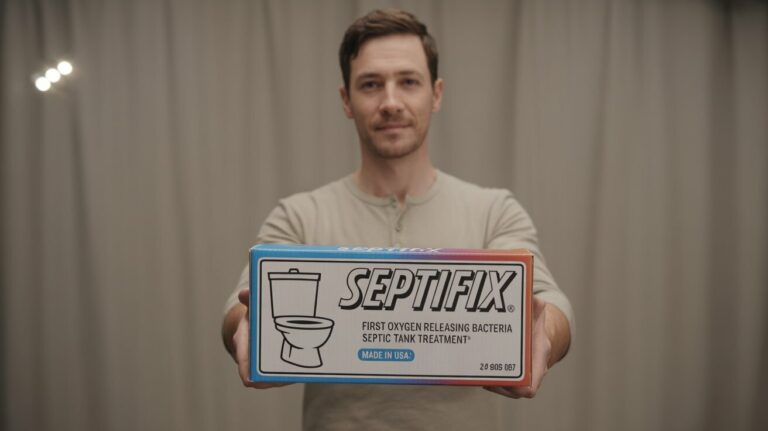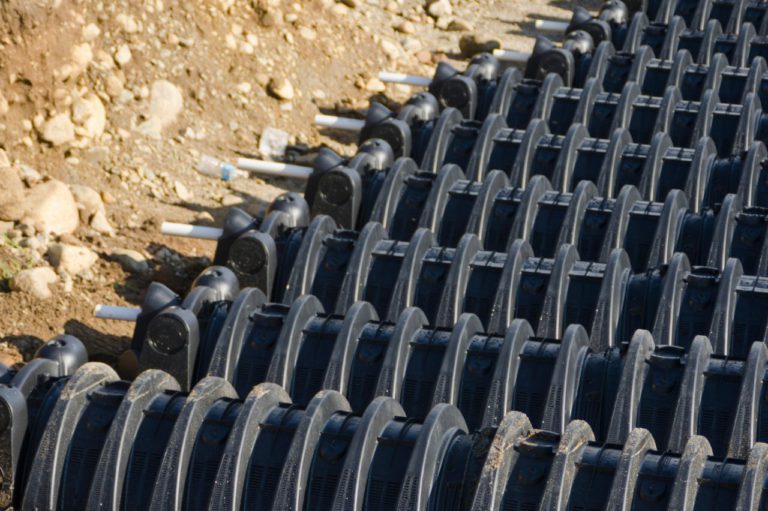10 Things You Should Never Flush Into a Septic Tank
Are you aware of the hidden dangers lurking in your septic system? Flushing the wrong items can lead to costly repairs, environmental hazards, and even health risks.
Proper septic tank maintenance is crucial to ensure the longevity of your system and the well-being of your family. But what exactly can you safely flush, and what should you avoid?
Understanding the importance of responsible septic system care is vital. By being mindful of what you flush, you can prevent backups, odors, and other issues that can arise from a clogged or failing septic system.
Key Takeaways
- Identify common household items that should never be flushed into a septic tank.
- Understand the consequences of improper septic tank maintenance.
- Learn simple practices to maintain a healthy septic system.
- Discover the benefits of regular septic tank inspections and pumping.
- Recognize the importance of being mindful of what you flush to prevent system failures.
The Hidden Dangers of Improper Septic Tank Disposal
Understanding the risks associated with improper septic tank disposal is vital for homeowners who rely on these systems for wastewater management. A well-functioning septic system is crucial for both the environment and public health.
How Your Septic System Functions
A septic system is an underground wastewater treatment structure that uses natural processes to treat and dispose of wastewater. It consists of a septic tank and a drainfield. The septic tank is where wastewater from your home flows into, allowing solids to settle and oils/grease to float to the top. The liquid wastewater then exits into the drainfield, where it’s filtered through soil, removing harmful bacteria and contaminants. Proper septic tank care involves regular inspections and pumping to ensure the system operates effectively.
| Component | Function |
|---|---|
| Septic Tank | Allows wastewater to separate into solids, liquids, and scum |
| Drainfield | Filters wastewater through soil, removing bacteria and contaminants |
Long-term Consequences of Flushing the Wrong Items
Flushing inappropriate items down the toilet can lead to significant septic tank issues. Non-biodegradable materials like plastics, sanitary products, and chemicals can clog the system, disrupt bacterial balance, and contaminate groundwater. Over time, this can result in costly repairs, environmental pollution, and health hazards. Understanding what not to flush is a critical aspect of septic system maintenance.
The long-term consequences can be severe, including system failure, which may require expensive pumping or even replacement of the entire system. Moreover, improper disposal can lead to the contamination of soil and groundwater, posing risks to both the environment and human health.
1. Feminine Hygiene Products: Pads, Tampons, and Applicators
Flushing feminine hygiene products down the toilet might seem convenient, but it poses significant risks to your septic system. These products are designed to absorb liquid and expand, which can cause serious issues when they enter your septic tank.
Why They Cause Serious Blockages
Feminine hygiene products do not break down like toilet paper. Instead, they accumulate in the septic tank and can cause blockages in the pipes, leading to backups and overflows. The absorbent nature of these products means they can swell and get stuck, obstructing the flow of wastewater. This can result in costly repairs and maintenance.
How They Affect Bacterial Balance
The bacterial balance in a septic tank is crucial for breaking down waste. Feminine hygiene products can disrupt this balance by introducing materials that are not easily biodegradable. The presence of these products can lead to a decrease in the efficiency of the septic system, causing it to fail. Maintaining the right balance of bacteria is essential for the proper functioning of your septic tank.
Proper Disposal Methods to Protect Your System
To avoid the problems associated with flushing feminine hygiene products, it’s essential to dispose of them properly. Wrapping used products in toilet paper or a small bag and disposing of them in the trash is a simple and effective method. Additionally, using menstrual cups or period panties can reduce the amount of waste generated. These alternatives are not only better for your septic system but also more environmentally friendly.
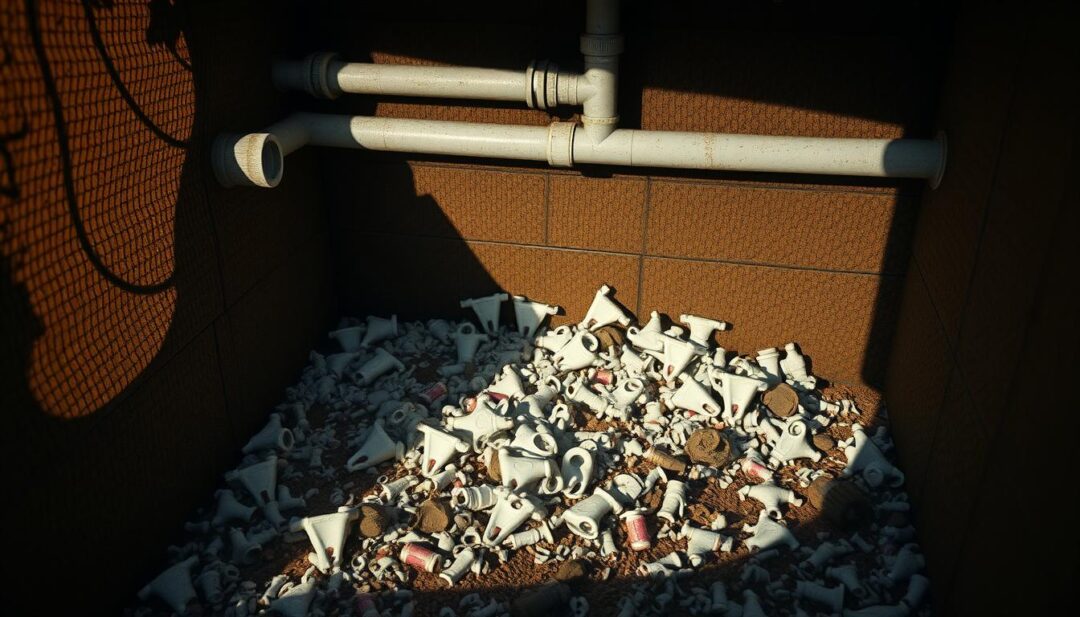
2. “Flushable” Wipes: The Marketing Myth
“Flushable” wipes are a marketing gimmick that can have disastrous consequences for your septic system. Many homeowners believe that these products are safe to flush down the toilet, but the reality is far different.

Why They Don’t Break Down Like Toilet Paper
Unlike toilet paper, “flushable” wipes are designed to be stronger and more durable, which means they don’t break down easily in water. This durability is the very reason they cause problems in septic systems, as they can accumulate and form clogs.
How They Create Costly Clogs
When “flushable” wipes are flushed, they can combine with other debris in your pipes, creating massive clogs that are expensive to clear. These clogs can lead to backups, overflows, and even damage to your septic tank and drainfield.
Better Alternatives for Personal Hygiene
For personal hygiene, consider using products that are designed to be septic-safe. For instance, toilet paper that’s labeled as “septic-safe” is a better choice. Additionally, using a bidet or adjusting your hygiene routine to minimize the use of wipes can significantly reduce the risk to your septic system.
By being mindful of what you flush, you can protect your septic system from unnecessary damage and costly repairs. Always look for products that are truly compatible with your septic tank to maintain its health and longevity.
3. Cooking Oils and Grease: Pipe-Clogging Culprits
The disposal of cooking oils and grease down the drain is a common practice that can have disastrous consequences for your septic tank. When these substances enter your plumbing system, they can cause significant problems that may lead to costly repairs.
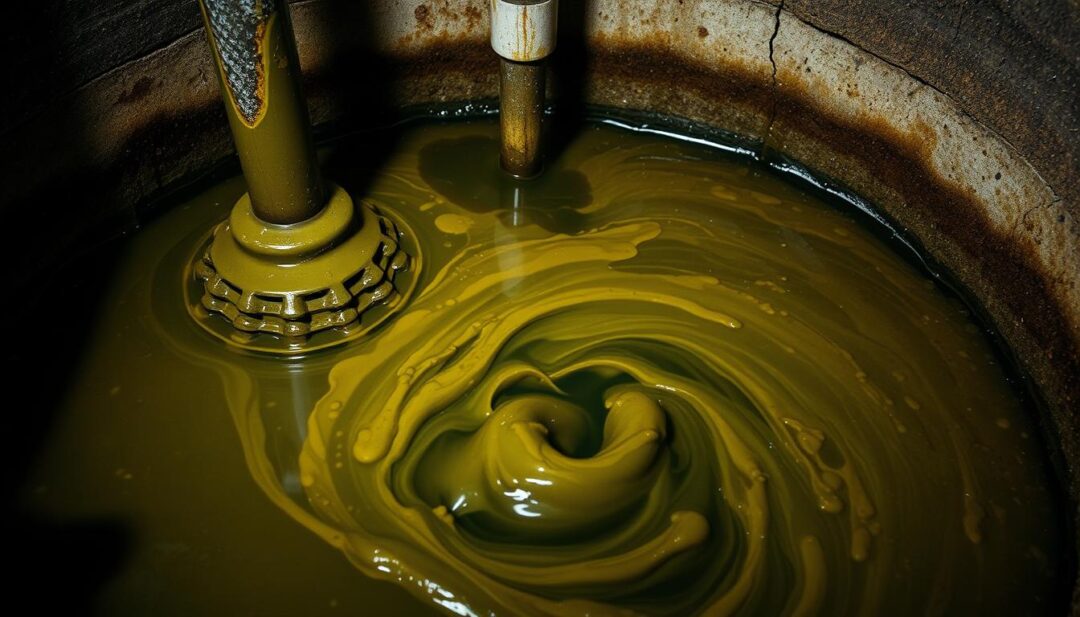
The Solidification Process in Your Pipes
Cooking oils and grease are liquids when hot, but they solidify as they cool down. In your pipes, this means they can stick to the walls and accumulate over time, forming a thick layer of fat and debris that can clog your pipes and damage your septic system.
Impact on Soil Absorption Field
When cooking oils and grease enter the septic tank, they can eventually make their way into the soil absorption field. Here, they can clog the pores in the soil, reducing its ability to absorb wastewater. This can lead to system failures and the need for costly repairs or even replacement.
Safe Collection and Disposal Techniques
To avoid these problems, it’s essential to dispose of cooking oils and grease properly. One method is to collect them in a designated container and then dispose of them in the trash. Some communities also have special collection programs for cooking oils. By taking these steps, you can help maintain your septic system’s health and avoid costly septic tank cleaning and septic tank maintenance.
| Disposal Method | Benefits |
|---|---|
| Collecting in a designated container | Easy to implement, reduces risk of pipe clogs |
| Community collection programs | Environmentally friendly, convenient |
As a homeowner, it’s crucial to be mindful of what you dispose of down the drain. By making a few simple changes to your daily habits, you can significantly reduce the risk of problems with your septic system.
“Proper disposal of cooking oils and grease is a critical aspect of septic system maintenance. By taking the time to do it correctly, homeowners can avoid costly repairs and ensure their system operates efficiently for years to come.”
4. Medications and Pharmaceuticals: Environmental Hazards
The improper disposal of pharmaceuticals poses significant risks to our ecosystem. When medications are flushed into septic systems, they can lead to a range of environmental and health issues.
How They Contaminate Groundwater
Pharmaceuticals that are not properly disposed of can leach into the groundwater, contaminating it with active drug ingredients. This contamination can affect both surface and groundwater sources, posing a risk to wildlife and human health.
Studies have shown that many water treatment plants are not equipped to remove pharmaceutical residues, leading to the presence of these contaminants in drinking water sources.
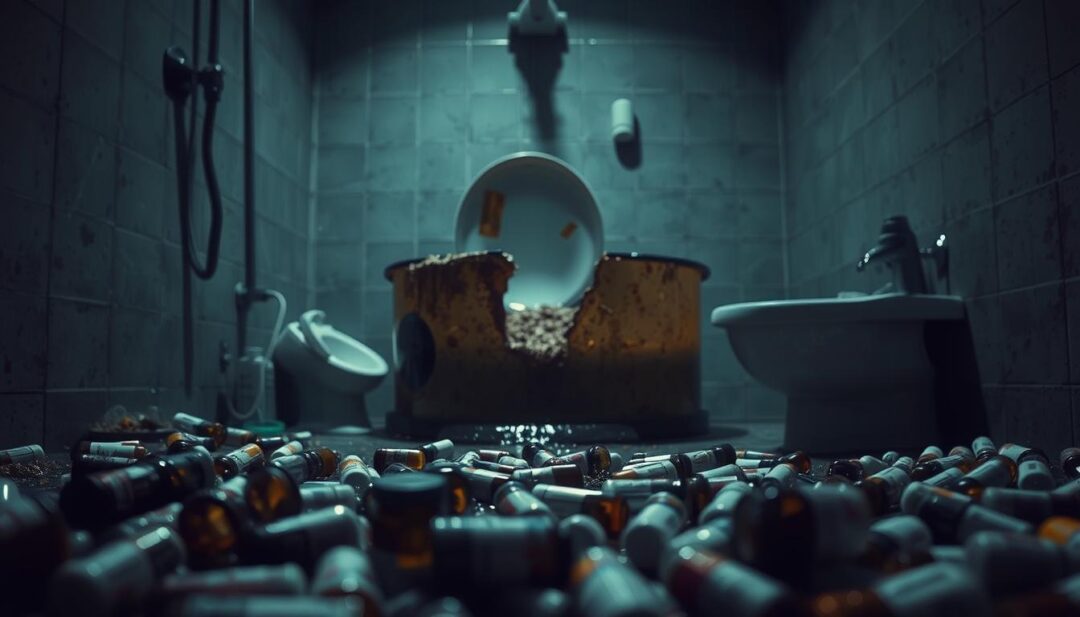
Effects on Septic Tank Bacteria
The bacteria in septic tanks are crucial for breaking down waste. However, certain pharmaceuticals can disrupt this process by killing off these beneficial bacteria, leading to system failures and potential environmental hazards.
When the balance of bacteria is disturbed, it can result in the inadequate treatment of wastewater, causing harm to the surrounding ecosystem.
Take-Back Programs and Proper Disposal Options
To mitigate these risks, many communities have established take-back programs for unused medications. These programs ensure that pharmaceuticals are disposed of in an environmentally safe manner.
Additionally, households can take steps to properly dispose of medications by following guidelines provided by local health departments or pharmacies, thus protecting both their septic systems and the environment.
| Disposal Method | Environmental Impact | Recommendation |
|---|---|---|
| Flushing Medications | High Risk of Groundwater Contamination | Avoid |
| Take-Back Programs | Low Environmental Impact | Recommended |
| Proper Disposal in Trash | Moderate Risk if Not Done Correctly | Follow Local Guidelines |
5. Household Chemicals and Cleaners: Bacterial Killers
Many household chemicals and cleaners pose a substantial threat to the bacteria that keep your septic system running smoothly. These chemicals can disrupt the delicate balance of your septic system, leading to a range of problems.
How They Destroy Essential Microorganisms
Household chemicals such as bleach and drain cleaners contain harsh ingredients that can kill off the beneficial bacteria in your septic tank. Without these bacteria, waste cannot be broken down properly, leading to backups and other issues. The loss of these microorganisms can have long-lasting effects on your system’s efficiency.
Specific Chemicals to Avoid
Some of the most harmful chemicals to avoid include:
- Toilet bowl cleaners
- Drain cleaners
- Bleach
- Ammonia-based products
These products can be replaced with gentler alternatives that are safer for your septic system.
Natural Cleaning Alternatives That Protect Your System
Consider switching to natural cleaning products that are designed to be septic-safe. For example, using baking soda and vinegar can be an effective way to clean your drains without harming your septic system. These alternatives not only protect your system but are also better for the environment.
| Chemical | Impact on Septic System | Alternative |
|---|---|---|
| Bleach | Kills beneficial bacteria | Hydrogen peroxide |
| Drain cleaners | Disrupts bacterial balance | Baking soda and vinegar |
| Ammonia | Harms microorganisms | Castile soap |

6. Paper Towels, Tissues, and Napkins: Not Like Toilet Paper
Unlike toilet paper, paper towels, tissues, and napkins are not designed to break down in water, posing a significant risk to your septic tank’s health. These products are made to be stronger and more absorbent, which means they don’t disintegrate like toilet paper when flushed.
Designed Not to Break Down When Wet
Paper towels, tissues, and napkins are engineered to retain their strength even when wet, making them useful for cleaning and personal hygiene. However, this characteristic also means they can cause problems in your septic system by not breaking down and potentially clogging pipes.
How They Contribute to System Overload
When these non-biodegradable paper products accumulate in your septic tank, they can lead to system overload. This overload can cause backups, increase maintenance costs, and potentially lead to system failure. It’s crucial to dispose of these items properly to avoid such issues.
Composting and Trash Disposal Alternatives
Instead of flushing, consider composting or disposing of paper towels, tissues, and napkins in the trash. Some paper products can be composted, reducing waste and creating nutrient-rich soil for your garden. For those that can’t be composted, wrapping them in a designated trash bag and disposing of them in the garbage is a safer alternative for your septic system.
7. Diapers and Baby Wipes: System-Clogging Nightmares
Diapers and baby wipes are a significant threat to the proper functioning of septic systems. Flushing these items can lead to costly repairs and maintenance issues. Homeowners with septic tanks need to be aware of the risks associated with disposing of diapers and baby wipes through their toilet.
Materials That Never Decompose in Septic Systems
Diapers and baby wipes are made from materials that do not break down easily in septic systems. These include absorbent gels, plastics, and other synthetic materials that can cause clogs and backups. It’s crucial to avoid flushing these items to prevent damage to your septic system.
The Special Problem with “Biodegradable” Versions
Even “biodegradable” diapers and baby wipes can cause issues. While they may break down more easily than their non-biodegradable counterparts, they still don’t decompose quickly enough to avoid causing problems in your septic system. The term “biodegradable” can be misleading, as it doesn’t necessarily mean these products are safe for your septic tank.
Diaper Disposal Systems and Better Practices
To avoid issues with diapers and baby wipes, it’s best to use a diaper disposal system. These systems are designed to contain odors and prevent the spread of bacteria. Regularly cleaning and maintaining your diaper disposal system can help keep your septic system safe. Consider using a diaper pail with a secure lid to prevent leakage and odors.
Here’s a comparison of different disposal methods for diapers and baby wipes:
| Disposal Method | Impact on Septic System | Recommendation |
|---|---|---|
| Flushing | High risk of clogs and backups | Avoid |
| Diaper Pail with Secure Lid | Low risk, contains odors and bacteria | Recommended |
| Regular Trash | Moderate risk, depends on wrapping and containment | Use with caution, wrap tightly |
In conclusion, diapers and baby wipes should not be flushed into septic systems. Using a diaper disposal system and being mindful of how you dispose of these items can help maintain the health of your septic tank. Regular septic tank cleaning and maintenance are also crucial to preventing costly repairs.
8. Coffee Grounds and Food Waste: Sediment Builders
Coffee grounds and food waste are common kitchen scraps that can have a significant impact on your septic system. While they may seem harmless, these materials can accumulate and cause problems in your tank.
Accumulation of Sludge
Coffee grounds and food waste contribute to the formation of sludge at the bottom of your septic tank. This sludge layer can grow thicker over time, reducing the tank’s effective volume and potentially leading to system failures.
Impact on System Performance: The accumulation of coffee grounds and food waste can lead to more frequent pumping needs, increasing maintenance costs.
Impact on Pumping Frequency and Costs
When coffee grounds and food waste are flushed into the septic system, they can significantly increase the frequency of pumping required to maintain the system’s health. This is because these materials do not break down easily and contribute to the sludge layer.
The increased pumping frequency directly translates to higher maintenance costs over time. Regularly disposing of coffee grounds and food waste through other means can help mitigate these expenses.
| Material | Breakdown Time | Impact on Septic System |
|---|---|---|
| Coffee Grounds | Slow | Increases sludge layer |
| Food Waste | Variable | Can cause clogs and increase sludge |
| Toilet Paper | Fast | Designed for septic systems |
Composting Benefits for Your Garden
Instead of flushing coffee grounds and food waste, consider composting them. Composting not only reduces the amount of waste sent to your septic system but also creates a nutrient-rich soil amendment for your garden.
Composting is a simple and effective way to recycle kitchen scraps, turning potential waste into a valuable resource. This practice supports a healthier septic system and a more sustainable gardening practice.
9. Cat Litter and Pet Waste: Parasite and Pathogen Risks
Flushing cat litter and pet waste into your septic system can lead to serious health risks and system failures. These materials are not designed to be processed by septic systems and can cause significant problems.
Toxoplasmosis and Other Health Concerns
Cat litter, particularly if it contains feces, can harbor the parasite Toxoplasma gondii, which causes toxoplasmosis. This condition can be severe in individuals with weakened immune systems and pregnant women. Flushing cat litter can spread this parasite into the environment, contaminating soil and water.
Clay and Silica Impact on Your System
Many cat litters are made from clay or silica, materials that do not break down in septic systems. These materials can accumulate, causing clogs and backups. Over time, they can also reduce the system’s ability to process wastewater effectively.
Pet Waste Composting and Municipal Guidelines
Instead of flushing, pet waste can be composted. However, it’s essential to follow municipal guidelines for composting pet waste to avoid creating additional health hazards. Some communities have specific programs for collecting and composting pet waste, providing a safer alternative to septic systems.
By understanding the risks associated with cat litter and pet waste, homeowners can take steps to protect their septic systems and the environment. Proper disposal methods, such as composting or using designated waste collection services, can mitigate these risks.
10. Dental Floss and Hair: Creating “Net-like” Traps
Dental floss and hair may seem harmless, but they can cause significant problems in your septic tank if not disposed of properly. These thin, stringy materials can entangle with other debris, creating “net-like” traps that catch additional waste, leading to clogs and backups in your system.
How They Create “Net-like” Traps in Your System
When dental floss and hair accumulate in your septic tank, they can form a web-like structure that traps other materials, such as grease and food particles. This can lead to the formation of large, impenetrable masses that disrupt the normal functioning of your septic system. As septic tank advice experts suggest, being mindful of what you flush down the drain is crucial to maintaining a healthy system.
Their Non-biodegradable Properties
Unlike toilet paper, which breaks down easily in water, dental floss and hair are not biodegradable. They do not decompose and can remain in your septic system for a long time, causing ongoing problems. This highlights the importance of following septic tank dos and don’ts to avoid costly repairs.
As a study on septic system failures notes, “The presence of non-biodegradable materials can significantly reduce the lifespan of a septic system.” Proper disposal of these items is essential to maintaining a functioning septic tank.
Simple Bathroom Trash Can Solutions
To avoid the problems associated with dental floss and hair, it’s recommended to dispose of them in a trash can rather than flushing them down the toilet. Keeping a small, convenient trash can in your bathroom can make it easy to throw away these items, reducing the risk of clogs and backups in your septic system. By following this simple septic tank advice, you can help ensure the longevity of your system.
By being mindful of what you dispose of and taking simple steps like using a bathroom trash can, you can significantly reduce the risk of problems with your septic system. This is a key part of septic tank dos and don’ts that every homeowner should know.
Conclusion: Protecting Your Investment and the Environment
Proper septic tank maintenance and care are crucial for the longevity of your septic system and the protection of the environment. By avoiding the disposal of harmful items into your septic tank, you can prevent costly repairs and minimize your ecological footprint.
As discussed, certain products like feminine hygiene products, “flushable” wipes, and cooking oils can cause significant damage to your septic system. By adopting responsible disposal practices and being mindful of what you flush, you can ensure the optimal functioning of your septic tank.
Regular septic tank maintenance not only safeguards your investment but also contributes to a healthier environment. By taking the necessary steps to protect your septic system, you can help prevent groundwater contamination and maintain a safe and sustainable ecosystem.
By incorporating these simple yet effective practices into your daily routine, you can enjoy a well-functioning septic system while doing your part for the environment.


